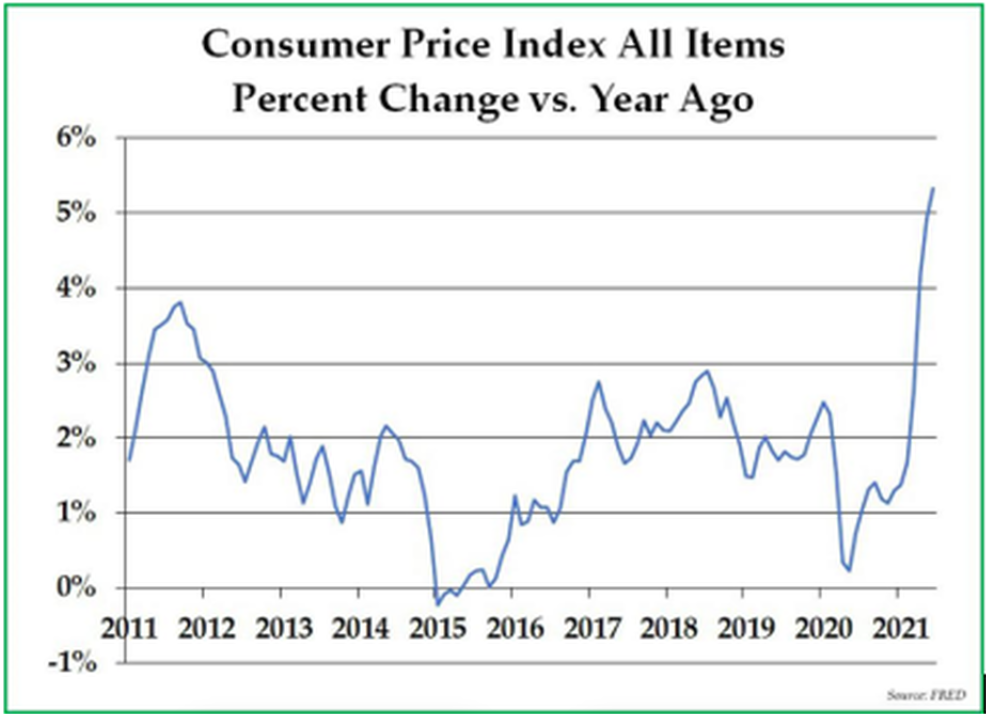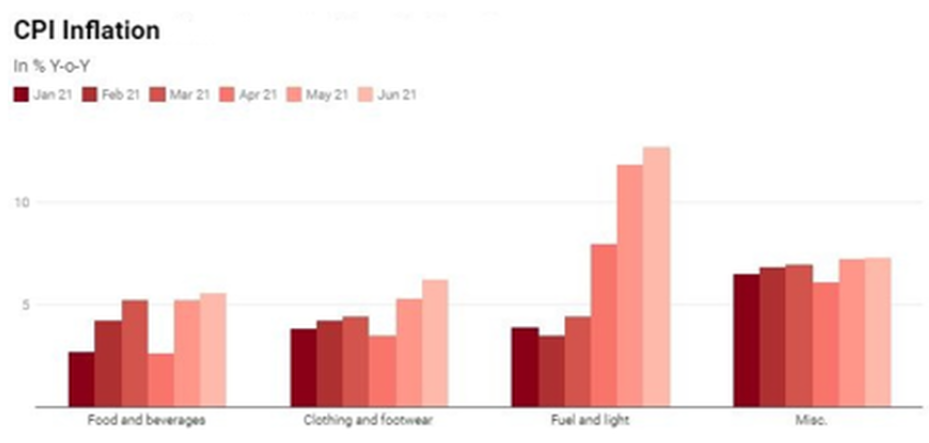Webster suggests transitory means “temporary,” “not persistent.” Perhaps transitory inflation can thus be best understood as only a brief period of time whereby the prices of goods and services increase.
The term "transitory" is becoming more common in discussions about inflation in India and around the world. Inflation has been higher than projected and has been increasing at a faster rate than in previous decades. The major central banks, on the other hand, have labeled it as transitory because it is mostly driven by one-off causes. They anticipate significant price hikes as a result of one-time variables that are not sustainable. However, the present list of one-time factors is extensive and diverse. As a result, the term "transitory" inflation does not imply a short-term price increase.
What happened in history?
When Fed Chairman Ben Bernanke testified to Congress in July 2011, increasing inflation was on everyone's mind. During the first half of the year, oil prices had soared above $110 per barrel, and the cost of filling a car tank with gasoline had doubled from just two years ago. The dramatic rise in food costs acted as a spark for a series of revolutions across the Middle East, now known as the Arab Spring. The consumer price index (“CPI”) increased by as much as 3.9% YoY, far exceeding the Federal Reserve's long-term inflation objective of 2% per year. Investors and consumers were concerned about inflation because of rising prices and the Federal Reserve's continuous purchases of US Treasuries and mortgage-backed securities, which many saw as inflationary.
Chairman Bernanke's prediction that inflation would be temporary in 2011 was spot on. Between 2012 and 2016, the year-over-year growth in consumer prices was between 0% and 2%.
Current scenario – US
Consumer Price Index:
Prices that Americans pay for everyday goods and services rose in July as pent-up demand for travel and restaurants kept inflation hot, but jumped about as much as economists had expected. The government said CPI increased 0.5% on a month-over-month basis. Economists and Fed panelists have stated that the current inflation trend is within their tolerance band and the current inflation is in line with their expectations.
Producer Price Index:
The producer price index increased by 7.8%. Nearly three-quarters of the increase was due to the 1.1% rise in prices for final demand services, the largest on record. Almost half of the increase was due to a 1.7% rise in margins for final demand trade services, which measure changes in margins received by wholesalers and retailers.
With the release of this latest inflation data, Federal Reserve Chairman Jay Powell finally admitted that the present inflationary impulse is higher than the Fed had anticipated while maintaining the current rate of inflation.
The Fed chairman, Jerome Powell, has been steadfast in his view that the spike in inflation is transitory; that it is a function of the disruption to supply chains caused by the pandemic and the distortions generated by the unprecedented fiscal response.
The annual Jackson Hole meeting which is to be held from the 26th to the 28th of August - is when the markets are expecting the Fed Chair Powell to provide more insights on when and how will the Fed start tapering its bond and mortgage purchases and its more current assessment of when the first rate rise in this cycle may occur. Inflation readings and the unemployment numbers would be the major catalysts.
Current scenario – India
Retail Inflation based on Consumer Price Index eased to a three-month low of 5.59% in July due to moderation in food prices. The inflation print has come within the RBI’s targeted range of 2 plus/minus 4% after two months, easing concerns of an immediate rate hike action by the central bank.
The RBI governor stated that “High rates of inflation are transitory and Inflation is showing signs of stickiness, but it is only a transitory hump that should moderate in the third quarter,".
RBI Governor also underlined the need to closely monitor the price hike situation in order to anchor the inflation expectations. RBI also revised its inflation forecast for FY22 to 5.7% from 5.1%. The RBI Governor still held onto the fact that the increase in inflation is just temporary.
RBI communications show that inflationary concerns don’t figure on their priority list for now. Like major central banks, RBI has consistently communicated that they are willing to look through any transitory inflation till ‘durable recovery’ returns. The MPC members seem to believe that it’s their duty to support growth recovery from the pandemic by providing ample liquidity.
Conclusion
The real transitory part is the very temporary inflation from a set of quirks related to the economy’s reopening impacting core prices. Supply chains are complex, and they have come under pressure during the pandemic, as companies are faced with challenges including raw material shortages, rising input prices, and longer delivery times.
This unusual dynamic could also last much beyond the next few months and will only reduce when the manufacturing costs come down.
Central banks apparently believe that they will only need to worry about entrenched inflation when demand returns. But it may well pose the biggest threat to the current nascent economic recovery. It’s premature to conclude all of this is transitory and where underlying inflation is ultimately going to land when we get through the price normalizations. The government is also running massive fiscal deficits and many central banks worldwide are beginning to consider how to pause or pare their accommodative stances.
Over the long run, there are several themes that would drive inflation dynamics. Below we list a few of them:
1) In the long run, if the de-dollarization continues, Commodities denominated in dollars would be impacted.
2) A purposefully weak Yuan and low-cost manufacturing has helped China export deflation around the world. So, it would be important to understand whether China would be comfortable with a stronger Yuan, given its inward emphasis and talks surrounding Yuan internalization.
3) It is believed that delays in mining clearances and limiting the supply of metals that are needed for the green push would have an effect on inflation. Also, factors surrounding climate change may have an impact on prices.
This report has been prepared by IFA Global. IFA Global shall not be in any way responsible for any loss or damage that may arise to any person from any inadvertent error in the information contained in this report. IFA Global nor any of directors, employees, agents or representatives shall be held liable for any damages whether direct, indirect, special or consequential including lost revenue or lost profits that may arise from or in connection with the use of the information. No liability whatsoever is accepted for any loss arising (whether direct or consequential) from any use of the information contained in this report. This statement, prepared specifically at the addressee(s) request is for information contained in this statement. All market prices, service taxes and other levies are subject to change without notice. Also the value, income, appreciation, returns, yield of any of the securities or any other financial instruments mentioned in this statement are based on current market conditions and as per the last details available with us and subject to change. The levels and bases of, and reliefs from, taxation can change. The securities / units / other instruments mentioned in this report may or may not be live at the time of statement generation. Please note, however, that some data has been derived from sources that we believe to be reliable but is not guaranteed. Please review this information for accuracy as IFA Global cannot be responsible for omitted or misstated data. IFA Global is not liable for any delay in the receipt of this statement. This information is strictly confidential and is being furnished to you solely for your information. This information should not be reproduced or redistributed or passed on directly or indirectly in any form to any other person or published, copied, in whole or in part, for any purpose. This report is not directed or intended for distribution to, or use by, any person or entity who is a citizen or resident of or located in any locality, state, country or other jurisdiction, where such distribution, publication, availability or use would be contrary to law, regulation or which would subject IFA Global to any registration or licensing requirements within such jurisdiction. The information given in this report is as of the date of this report and there can be no assurance that future results or events will be consistent with this information. IFA Global reserves the right to make modifications and alterations to this statement as may be required from time to time. However, IFA Global is under no obligation to update or keep the information current. Nevertheless, IFA Global is committed to providing independent and transparent information to its client and would be happy to provide any information in response to specific client queries. Neither IFA Global nor any of its directors, employees, agents or representatives shall be liable for any damages whether direct, indirect, special or consequential including lost revenue or lost profits that may arise from or in connection with the use of the information. The information provided in these report remains, unless otherwise stated, the copyright of IFA Global. All layout, design, original artwork, concepts and other Intellectual Properties, remains the property and copyright IFA Global and may not be used in any form or for any purpose whatsoever by any party without the express written permission of the copyright holders.
Recommended Content
Editors’ Picks
EUR/USD hovers around 1.0700 after German IFO data

EUR/USD stays in a consolidation phase at around 1.0700 in the European session on Wednesday. Upbeat IFO sentiment data from Germany helps the Euro hold its ground as market focus shifts to US Durable Goods Orders data.
USD/JPY refreshes 34-year high, attacks 155.00 as intervention risks loom

USD/JPY is renewing a multi-decade high, closing in on 155.00. Traders turn cautious on heightened risks of Japan's FX intervention. Broad US Dollar rebound aids the upside in the major. US Durable Goods data are next on tap.
Gold price flat lines above $2,300 mark, looks to US macro data for fresh impetus

Gold price (XAU/USD) struggles to capitalize on the previous day's bounce from over a two-week low – levels just below the $2,300 mark – and oscillates in a narrow range heading into the European session on Wednesday.
Worldcoin looks set for comeback despite Nvidia’s 22% crash Premium

Worldcoin price is in a better position than last week's and shows signs of a potential comeback. This development occurs amid the sharp decline in the valuation of the popular GPU manufacturer Nvidia.
Three fundamentals for the week: US GDP, BoJ and the Fed's favorite inflation gauge stand out Premium

While it is hard to predict when geopolitical news erupts, the level of tension is lower – allowing for key data to have its say. This week's US figures are set to shape the Federal Reserve's decision next week – and the Bank of Japan may struggle to halt the Yen's deterioration.



